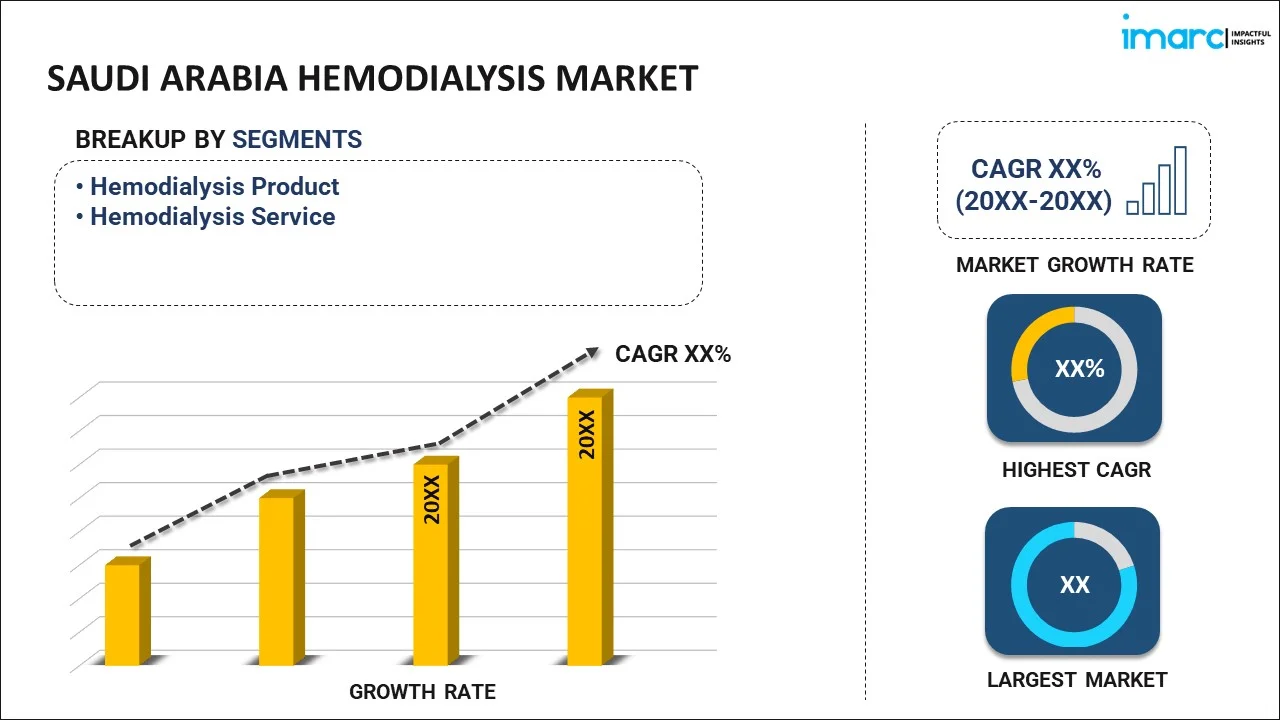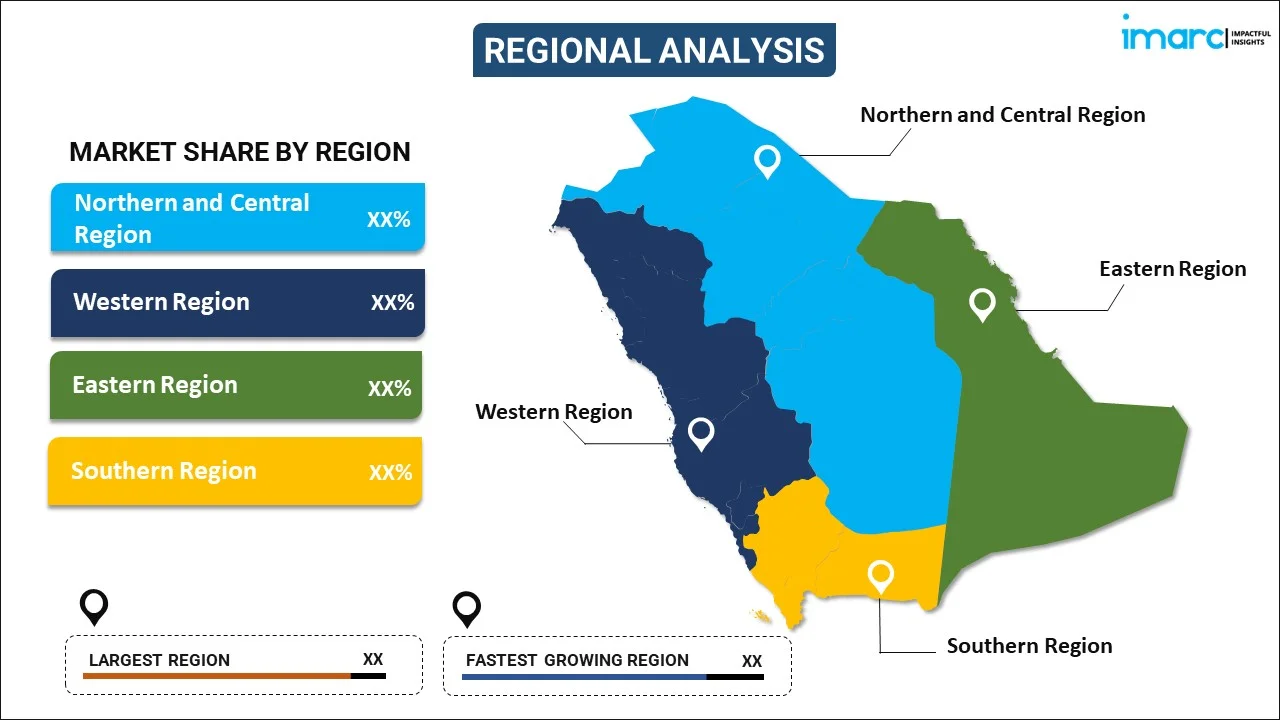
Saudi Arabia Hemodialysis Market Report by Segment (Hemodialysis Product, Hemodialysis Service), Modality (Conventional Hemodialysis, Short Daily Hemodialysis, Nocturnal Hemodialysis), End User (Hospitals, Independent Dialysis Centers, and Others), and Region 2025-2033
Market Overview:
The Saudi Arabia hemodialysis market size reached USD 842 Million in 2024. Looking forward, IMARC Group expects the market to reach USD 1,219 Million by 2033, exhibiting a growth rate (CAGR) of 4.2% during 2025-2033. The increasing prevalence of chronic kidney disease due to factors like diabetes and hypertension, the rising geriatric population that is more susceptible to kidney-related issues and kidney failure, and investments in healthcare infrastructure represent some of the key factors driving the market.
|
Report Attribute
|
Key Statistics
|
|---|---|
|
Base Year
|
2024 |
|
Forecast Years
|
2025-2033
|
|
Historical Years
|
2019-2024
|
| Market Size in 2024 | USD 842 Million |
| Market Forecast in 2033 | USD 1,219 Million |
| Market Growth Rate (2025-2033) | 4.2% |
Hemodialysis is a medical procedure used to treat individuals with kidney failure, a condition where the kidneys are unable to adequately filter waste products and excess fluids from the blood. This procedure helps maintain the body's internal balance of electrolytes, fluids, and waste products when the kidneys are not functioning properly. During hemodialysis, a patient's blood is removed from their body and passed through a dialysis machine, which acts as an artificial kidney. Within this machine, blood flows through a filter (dialyzer) that removes waste products and excess fluids. Hemodialysis is typically performed three times a week, with each session lasting several hours. The frequency and duration depend on the individual's kidney function and overall health. Besides, patients undergoing hemodialysis are closely monitored during the procedure to ensure that their vital signs, electrolyte levels, and fluid balance are maintained within safe limits. Hemodialysis is a critical and life-saving procedure for people with advanced kidney disease. It helps alleviate symptoms of kidney failure, such as fatigue, fluid retention, and toxin buildup, and it allows individuals to maintain a relatively normal lifestyle while managing their condition.
Saudi Arabia Hemodialysis Market Trends:
Saudi Arabia has witnessed an increasing prevalence of chronic kidney disease, primarily due to factors like diabetes and hypertension. As the incidence of CKD rises, so does the demand for hemodialysis treatment. In addition, an aging population is more susceptible to kidney-related issues and kidney failure. Saudi Arabia's demographic shift toward an older population contributes to the growth in demand for hemodialysis services. Besides, the Saudi government has initiated various healthcare programs and projects to improve the quality of care and access to treatment. These initiatives support the expansion and enhancement of hemodialysis services across the country. Moreover, the NTP and Vision 2030 plans place a strong emphasis on improving healthcare infrastructure, which includes expanding the capacity for hemodialysis services and improving the quality of care. Additionally, investments in healthcare infrastructure, including the establishment of new medical facilities and the procurement of advanced medical equipment, contribute to the growth of the hemodialysis market. Furthermore, Saudi Arabia has emerged as a medical tourism destination for neighboring countries. Patients from the Middle East and North Africa region come to Saudi Arabia for advanced healthcare services, including hemodialysis, driving demand. Apart from this, expanding health insurance coverage in Saudi Arabia ensures that a larger portion of the population can access hemodialysis treatment without facing financial barriers.
Saudi Arabia Hemodialysis Market Segmentation:
IMARC Group provides an analysis of the key trends in each segment of the market, along with forecasts at the country level for 2025-2033. Our report has categorized the market based on segment, modality, and end user.
Segment Insights:

- Hemodialysis Product
- Machines
- Dialyzers
- Others
- Hemodialysis Service
- In-centre Services
- Home Services
The report has provided a detailed breakup and analysis of the market based on the segment. This includes hemodialysis product (machines, dialyzers, and others) and hemodialysis service (in-center services and home services).
Modality Insights:
- Conventional Hemodialysis
- Short Daily Hemodialysis
- Nocturnal Hemodialysis
A detailed breakup and analysis of the market based on the modality have also been provided in the report. This includes conventional hemodialysis, short daily hemodialysis, and nocturnal hemodialysis.
End User Insights:
- Hospitals
- Independent Dialysis Centers
- Others
The report has provided a detailed breakup and analysis of the market based on the end user. This includes hospitals, independent dialysis centers, and others.
Regional Insights:

- Northern and Central Region
- Western Region
- Eastern Region
- Southern Region
The report has also provided a comprehensive analysis of all the major regional markets, which include Northern and Central Region, Western Region, Eastern Region, and Southern Region.
Competitive Landscape:
The market research report has also provided a comprehensive analysis of the competitive landscape. Competitive analysis such as market structure, key player positioning, top winning strategies, competitive dashboard, and company evaluation quadrant has been covered in the report. Also, detailed profiles of all major companies have been provided. Some of the key players include:
- Almana Group of Hospitals
- DaVita
- Diaverum Al Khobar
(Please note that this is only a partial list of the key players, and the complete list is provided in the report.)
Saudi Arabia Hemodialysis Market Report Coverage:
| Report Features | Details |
|---|---|
| Base Year of the Analysis | 2024 |
| Historical Period | 2019-2024 |
| Forecast Period | 2025-2033 |
| Units | Million USD |
| Scope of the Report | Exploration of Historical and Forecast Trends, Industry Catalysts and Challenges, Segment-Wise Historical and Predictive Market Assessment:
|
| Segments Covered |
|
| Modalities Covered | Conventional Hemodialysis, Short Daily Hemodialysis, Nocturnal Hemodialysis |
| End Users Covered | Hospitals, Independent Dialysis Centers, Others |
| Regions Covered | Northern and Central Region, Western Region, Eastern Region, Southern Region |
| Companies Covered | Almana Group of Hospitals, DaVita, Diaverum Al Khobar, etc. |
| Customization Scope | 10% Free Customization |
| Post-Sale Analyst Support | 10-12 Weeks |
| Delivery Format | PDF and Excel through Email (We can also provide the editable version of the report in PPT/Word format on special request) |
Key Questions Answered in This Report:
- How has the Saudi Arabia hemodialysis market performed so far and how will it perform in the coming years?
- What has been the impact of COVID-19 on the Saudi Arabia hemodialysis market?
- What is the breakup of the Saudi Arabia hemodialysis market on the basis of segment?
- What is the breakup of the Saudi Arabia hemodialysis market on the basis of modality?
- What is the breakup of the Saudi Arabia hemodialysis market on the basis of end user?
- What are the various stages in the value chain of the Saudi Arabia hemodialysis market?
- What are the key driving factors and challenges in the Saudi Arabia hemodialysis?
- What is the structure of the Saudi Arabia hemodialysis market and who are the key players?
- What is the degree of competition in the Saudi Arabia hemodialysis market?
Key Benefits for Stakeholders:
- IMARC’s industry report offers a comprehensive quantitative analysis of various market segments, historical and current market trends, market forecasts, and dynamics of the Saudi Arabia hemodialysis market from 2019-2033.
- The research report provides the latest information on the market drivers, challenges, and opportunities in the Saudi Arabia hemodialysis market.
- Porter's five forces analysis assist stakeholders in assessing the impact of new entrants, competitive rivalry, supplier power, buyer power, and the threat of substitution. It helps stakeholders to analyze the level of competition within the Saudi Arabia hemodialysis industry and its attractiveness.
- Competitive landscape allows stakeholders to understand their competitive environment and provides an insight into the current positions of key players in the market.
Need more help?
- Speak to our experienced analysts for insights on the current market scenarios.
- Include additional segments and countries to customize the report as per your requirement.
- Gain an unparalleled competitive advantage in your domain by understanding how to utilize the report and positively impacting your operations and revenue.
- For further assistance, please connect with our analysts.
 Inquire Before Buying
Inquire Before Buying
 Speak to an Analyst
Speak to an Analyst
 Request Brochure
Request Brochure
 Request Customization
Request Customization




.webp)




.webp)












